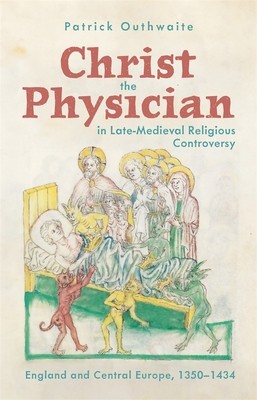
- We will send in 10–14 business days.
- Author: Patrick Outhwaite
- Publisher: York Medieval Press
- ISBN-10: 1914049268
- ISBN-13: 9781914049262
- Format: 15.6 x 23.4 x 1.8 cm, kieti viršeliai
- Language: English
- SAVE -10% with code: EXTRA
Christ the Physician in Late-Medieval Religious Controversy (e-book) (used book) | bookbook.eu
Reviews
Description
A consideration of the allegory of Christ the Divine Physician in medical and religious writings.
Discourses of physical and spiritual health were intricately entwined in the Middle Ages, shaping intellectual concepts as well as actual treatment. The allegory of Christ as Divine Physician is an example of this intersection: it appears frequently in both medical and religious writings as a powerful figure of healing and salvation, and was invoked by dissidents and reformists in religious controversies. Drawing on previously unexplored manuscript material, this book examines the use of the Christus Medicus tradition during a period of religious turbulence. Via an interdisciplinary analysis of literature, sermons, and medical texts, it shows that Wycliffites in England and Hussites in Bohemia used concepts developed in hospital settings to press for increased lay access to Scripture and the sacraments against the strictures of the Church hierarchy. Tracing a story of reform and controversy from localised institutional contexts to two of the most important pan-European councils of the fifteenth century, Constance and Basel, it argues that at a point when the body of the Church was strained by multiple popes, heretics and schismatics, the allegory came into increasing use to restore health and order.EXTRA 10 % discount with code: EXTRA
The promotion ends in 23d.10:29:45
The discount code is valid when purchasing from 10 €. Discounts do not stack.
- Author: Patrick Outhwaite
- Publisher: York Medieval Press
- ISBN-10: 1914049268
- ISBN-13: 9781914049262
- Format: 15.6 x 23.4 x 1.8 cm, kieti viršeliai
- Language: English English
A consideration of the allegory of Christ the Divine Physician in medical and religious writings.
Discourses of physical and spiritual health were intricately entwined in the Middle Ages, shaping intellectual concepts as well as actual treatment. The allegory of Christ as Divine Physician is an example of this intersection: it appears frequently in both medical and religious writings as a powerful figure of healing and salvation, and was invoked by dissidents and reformists in religious controversies. Drawing on previously unexplored manuscript material, this book examines the use of the Christus Medicus tradition during a period of religious turbulence. Via an interdisciplinary analysis of literature, sermons, and medical texts, it shows that Wycliffites in England and Hussites in Bohemia used concepts developed in hospital settings to press for increased lay access to Scripture and the sacraments against the strictures of the Church hierarchy. Tracing a story of reform and controversy from localised institutional contexts to two of the most important pan-European councils of the fifteenth century, Constance and Basel, it argues that at a point when the body of the Church was strained by multiple popes, heretics and schismatics, the allegory came into increasing use to restore health and order.

Reviews